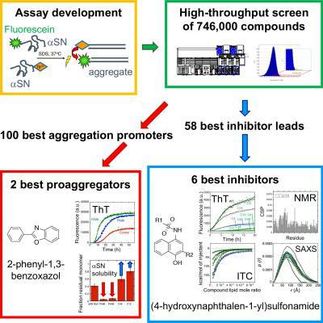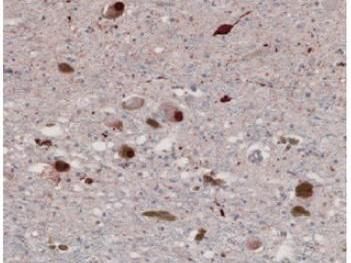Parkinson's disease - New test procedure enables early detection in patients at risk
Up to seven years before the onset of typical motor symptoms
In an international cooperation project, researchers from the University Medical Center Göttingen (UMG), the Paracelsus-Elena-Klinik Kassel and University College London (UCL) have developed a test procedure that makes it possible to predict the diagnosis of Parkinson's disease in at-risk patients up to seven years before the onset of typical motor symptoms using a blood sample. The next step is to further develop this test for clinical application. The four-year PROPAG-AGING project was funded by the EU with a total of around six million euros. The results have been published in the journal Nature Communications.

Symbolic image
Computer-generated image
Parkinson's disease is the second most common neurodegenerative disease and is becoming increasingly common in the population. In addition to motor symptoms such as slowness of movement, increased muscle tension and tremors, those affected also show non-motor symptoms such as olfactory and sleep disorders and depression. The disease is caused by the progressive breakdown of certain nerve cells in the brain, resulting in a deficiency of the neurotransmitter dopamine. The balance of dopamine and other neurotransmitters in the brain is crucial for the proper functioning of the musculoskeletal system. If the dopamine is missing, the movement processes are disturbed. Until now, the diagnosis has mainly been based on motor symptoms, which only occur when more than 70 percent of the dopamine-containing nerve cells have already been degraded. There are currently no clues, so-called biomarkers, that can indicate the specific disease process simply, directly and, above all, at an early stage.
Scientists at the University Medical Center Göttingen (UMG) and University College London have now succeeded in using blood samples and artificial intelligence to predict Parkinson's disease in patients with an increased risk of developing the disease seven years before the onset of typical motor symptoms. In a first step, proteins in blood samples from Parkinson's patients at the Paracelsus-Elena-Klinik Kassel and healthy study participants were analyzed using modern mass spectrometry. It was possible to identify 23 proteins that showed differences between the diseased and healthy participants and could therefore be considered biomarkers for the disease. In a second step, these 23 proteins were examined in the blood samples of people with isolated rapid eye movement (REM) sleep behavior disorder, which represents a high risk for Parkinson's disease. Using artificial intelligence, eight of the 23 proteins were able to predict Parkinson's disease for 79 percent of these high-risk patients up to seven years before the onset of symptoms. The method is to be confirmed in further studies and further developed for clinical application. The four-year PROPAG-AGING project was funded by the EU with a total of around six million euros.
"By determining eight proteins in the blood, we can identify potential Parkinson's patients several years in advance. Drug therapies could be given at an earlier stage, which could possibly slow down the progression of the disease or even prevent it from occurring," says Dr. Michael Bartl, resident physician at the Department of Neurology and member of the UMG's Translational Biomarker Research in Neurodegenerative Diseases working group and one of the first authors of the study. "We have not only developed a test, but also make the diagnosis using eight marker proteins that are directly linked to processes such as inflammation and the breakdown of non-functional proteins. These markers also represent potential targets for drug treatments," added Dr. Bartl.
The study in detail
The study compared the differences in proteins in blood plasma or serum between 99 Parkinson's patients and 36 healthy controls. The Parkinson's patients were participants in the De Novo Parkinson's (DeNoPa) study at the Paracelsus-Elena-Klinik Kassel, which has been running since 2009 and aims to follow Parkinson's disease from the first symptoms onwards from a long-term perspective. The blood samples were analyzed using mass spectrometry, a technical process for separating atoms and molecules based on mass and charge, and the concentration of various blood proteins was determined. The analyses were carried out in close cooperation with Professor Kevin Mills and Dr. Jenny Hällqvist, who specialize in the application of mass spectrometry to identify new biomarkers and precision tests in the Translational Mass Spectrometry Research Group at University College London, UK. The data was then analyzed using machine learning, a branch of artificial intelligence. Computer systems learn to recognize patterns and correlations in data and thereby improve themselves. Differences were identified in 23 proteins.
In a further step, the blood samples of 72 patients with isolated REM sleep behaviour disorder, which is characterized by vivid dreams and physical activity during dream sleep and poses a high risk of Parkinson's disease later in life, were examined in comparison to the healthy control group of 36 participants using machine learning. At the time of the first blood sample, none of the subjects with sleep behavior disorder had motor signs of Parkinson's disease. Both groups were examined over a period of ten years.
In the study, 23 proteins in the blood samples were identified as possible biomarkers for Parkinson's disease using mass spectrometry. With the help of machine learning, eight of these proteins were able to predict Parkinson's disease up to seven years in advance in 79 percent of at-risk patients with REM sleep behavior disorder. This was confirmed clinically in the long-term observation. During the course of the study, 16 of these patients developed Parkinson's disease.
"The aim is now to use a simplified procedure to carry out the tests not only on patients with an increased risk of Parkinson's disease, but also on a population basis. A well-founded data situation is necessary to establish a diagnostic test and to transfer the results into general clinical application," explains Professor Dr. Brit Mollenhauer, Professor at the Department of Neurology and Head of the "Translational Biomarker Research in Neurodegenerative Diseases" working group at the UMG, Chief Physician of the Department of Neurology at the Paracelsus-Elena-Klinik Kassel and last author of the study.
These studies have already begun: Firstly, in addition to other people with an isolated REM sleep behavior disorder, other at-risk individuals with a reduced ability to smell are also being examined. The scientists in Kassel are also conducting the "Healthy Ageing" study: For this, 170,000 people between the ages of 50 and 80 were contacted and asked to complete a questionnaire on risk symptoms for Parkinson's disease and/or dementia. Almost 10,000 people responded to the call; in a second step, 3,000 were sent a smell test and by the end of this year, 300 people with a high or low risk will be examined in the clinic; blood will also be taken for further testing of the new test procedure. This risk group will also be examined in Lübeck, Tübingen, Innsbruck (Austria), Barcelona (Spain), Luxembourg (Luxembourg) and London (UK) under the leadership of the UMG and the Paracelsus-Elena-Klinik Kassel.
Original publication
Plasma proteomics identify biomarkers predicting Parkinson’s disease up to 7 years before symptom onset. Jenny Hällqvist, Michael Bartl, Mohammed Dakna,...Maria-Lucia Muntean, Friederike Sixel-Döring, Claudio Franceschi, Ivan Doykov, Justyna Śpiewak, Héloїse Vinette, Claudia Trenkwalder, Wendy E. Heywood, Kevin Mills, Brit Mollenhauer. Nature Communications (2024)
See the theme worlds for related content
Topic World Mass Spectrometry
Mass spectrometry enables us to detect and identify molecules and reveal their structure. Whether in chemistry, biochemistry or forensics - mass spectrometry opens up unexpected insights into the composition of our world. Immerse yourself in the fascinating world of mass spectrometry!

Topic World Mass Spectrometry
Mass spectrometry enables us to detect and identify molecules and reveal their structure. Whether in chemistry, biochemistry or forensics - mass spectrometry opens up unexpected insights into the composition of our world. Immerse yourself in the fascinating world of mass spectrometry!

























































